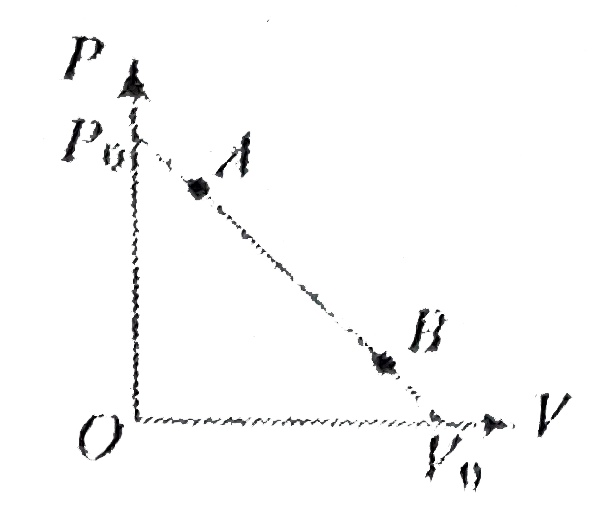Three samples A, B and C of the same gas (γ=1.5) have equal volumes and temperatures. The volume of each sample is doubled, the process being isothermal for A, adiabatic for B and isobaric for C. If the final pressures are equal for the three samples, Find the ratio of the initial pressures.
2√2:2:1
2√2:1:2
√2:1:2
2:1√2
The correct Answer is:B
b. Let the initial pressure of the three sample be PA,PB and PC, then
PA(V)3/2=(2V)3/2P(∵PB=P)
or PA=P(2)3/2
PC(V)=P(2V)
or PC=2P
∴PA:P:PC
=(2)3/2:1:2=2√2:1:2
Topper's Solved these Questions
- KINETIC THEORY OF GASES AND FIRST LAW OF THERMODYNAMICSBook:CENGAGE PHYSICS ENGLISHChapter:KINETIC THEORY OF GASES AND FIRST LAW OF THERMODYNAMICSExercise:Multiple Corrects
Explore 28 Videos
- KINETIC THEORY OF GASES AND FIRST LAW OF THERMODYNAMICSBook:CENGAGE PHYSICS ENGLISHChapter:KINETIC THEORY OF GASES AND FIRST LAW OF THERMODYNAMICSExercise:Assertion-Reasoning
Explore 6 Videos
- KINETIC THEORY OF GASES AND FIRST LAW OF THERMODYNAMICSBook:CENGAGE PHYSICS ENGLISHChapter:KINETIC THEORY OF GASES AND FIRST LAW OF THERMODYNAMICSExercise:Subjective
Explore 22 Videos
- KINETIC THEORY OF GASESBook:CENGAGE PHYSICS ENGLISHChapter:KINETIC THEORY OF GASESExercise:Compression
Explore 2 Videos
- LINEAR AND ANGULAR SIMPLE HARMONIC MOTIONBook:CENGAGE PHYSICS ENGLISHChapter:LINEAR AND ANGULAR SIMPLE HARMONIC MOTIONExercise:Single correct anwer type
Explore 14 Videos
Similar Questions
For an ideal gas
View SolutionStatement I: A quasi -static process is so called bacause it is a sudden and large change of the system.
Statement II: An adiabatic process is not quasi- static because it is a sudden and large change of the system.
View SolutionFive grams of helium having rms speed of molecules 1000m/s and 24g of oxygen having rms speed of 1000m/s are introduced into a thermally isolated vessel. Find the rms speeds of helium and oxygen individually when thermal equilibrium is attained. Neglect the heat capacity of vessel.
View SolutionOne mole of an ideal monatomic gas undergoes a linear process from A to B , in which is pressure P and its volume V change as shown in figure .

The absolute temperature T versus volume V for the given process is
View SolutionThe period of a simple pendulum whose bob is hollow metallic sphere is T. The period is T1 when the bob is filled with sand, T2 where it is filled with mercury and T3 when it is half filled with mercury Which of the following is true?

View SolutionThree samples A, B and C of the same gas (γ=1.5) have equal volumes and temperatures. The volume of each sample is doubled, the process being isothermal for A, adiabtic for B and isobaric for C. If the final pressures are equal for the three samples, Find the ratio of the initial pressures.
View SolutionTwo sample A and B of a gas initially at the square at the same pressure and temperature are compressed from volume V to V//2 (A isothermally and B adiabatically). The final pressure of A is
View SolutionInitial volume of three samples of same gas A, B and C are same. The process A is adiabatic, B is isobaric and C is isothermal. Each of the sample has same final pressure and volume. The initial pressure of which sample was maximum.
View SolutionThree samples of the same gas A,B and C (γ=3/2) have initially equal volume. Now the volume of each sample is doubled. The process is adiabatic for A. Isobaric for B and isothermal for C. If the final pressures are equal for all three samples, find the ratio of their initial pressures
View SolutionThree sample, A,B,C of a gas initially have the same volume. The volume of each sample is doubled by the following processes: (i) isothermal process on A, (ii) adiabatic process on B, and (iii) isobaric process on C. In which process will the work done be highest?
View SolutionTwo samples A and B of a gas are initially at the same temperature and pressure are compressed from volume V1 to V/2 (A isothermally and B adiabatically). The final pressure is
View Solutionएक ही गैस (γ=3/2) के तीन नमूनों A, B एवं C के प्रारंभिक आयतन समान हैं। अब प्रत्येक नमूने का आयतन दोगुना कर दिया जाता है, A के लिए प्रक्रम रुद्धोन, B के लिए समदाबी एवं C के लिए समतापी है। यदि तीनों नमूनों के अन्तिम दाब समान हैं, तब इनके प्रारम्भिक दाबों का अनुपात होगा
View SolutionThree samples of the same gas A, B and C (gamma = 3//2) have equal volume initially. Now, the volume of each sample is doubled. For A, the process is adiabatic , for B, it is isobaric and for C, the process is isothermal. If the final pressures are equal for all the three samples, the ratio of their initial pressures is
View Solutionसमान गैस A, B एवं C के तीनों नमूनों के आयतन प्रारम्भ में समान हैं। अब, प्रत्येक नमूने का आयतन दोगुना हो जाता है। A के लिए, प्रक्रम रुद्धोष्म है, B के लिए, यह समदाबी है तथा C के लिए, प्रक्रम समतापीय है। यदि अंतिम दाब सभी तीनों नमूनों के लिए समान है, तो उनके प्रारंभिक दाबों का अनुपात होगा
View SolutionThree samples A, B and C of the same gas (γ=1.5) have equal volumes and temperatures. The volume of each sample is doubled, the process being isothermal for A, adiabtic for B and isobaric for C. If the final pressures are equal for the three samples, Find the ratio of the initial pressures.
View SolutionThree samples of the same gas A,B and C (γ=3/2) have initially equal volume. Now the volume of each sample is doubled. The process is adiabatic for A. Isobaric for B and isothermal for C. If the final pressures are equal for all three samples, find the ratio of their initial pressures
View Solution
